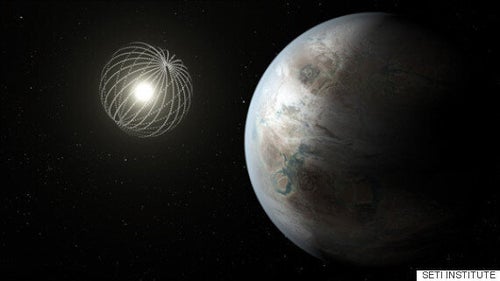Brian Cox has theorised that "an advanced alien civilisation" could be responsible for the bizarre behaviour of the KIC star that sent the internet into meltdown a few weeks ago.
In an interview with BBC Radio 6’s breakfast show, he used the Dyson sphere theory to explain why it would not be "horrendously surprising" to think that the star might be powering another civilisation.
Experts from the SETI Institute have also shed light on the star's behaviour, explaining, via a statement, that it is "quite likely due to nature and not aliens."


Artist impression of an exoplanet and its dyson swarm
"It is a thing called the Dyson sphere, which is where an ultra-advanced civilisation basically surrounds their whole star in a sphere of solar panels, which would get every last bit of energy from the star, so they could build their big space-faring interstellar civilisation," Professor Cox told BBC Radio 6.
SEE ALSO:
- Kepler's 'Alien Megastructure' Is Now The Focus Of SETI Researchers Looking For Extraterrestrial Life
- Letter To Aliens To Be Written By UK Researchers
- Aliens On Pluto Rumours Gain Momentum As NASA Scientist Says 'Amazing' Announcement Ahead
- Alien Life On Jupiter Investigated As ESA Launches Work On JUICE Spacecraft
- Seti's Top Alien Expert Says Humans Are Not Clever Enough To Read Extraterrestrial Messages
"I emphasise, it probably isn’t solar panels, but it’s data that isn’t explained at the moment and it wouldn’t be horrendously surprising if it turned out there was an advanced alien civilisation there that was way ahead of us and had built some big solar panels. I wouldn’t go “that’s impossible”, it isn’t."
However, SETI Institute experts studying the star system published data ruling out aliens as the reason behind the odd light dimming patterns.
Using the Allen Telescope Array, scientists looked for two different types of signals narrow-band and broad-band.
The narrow-band signals are the most frequently sought after in SETI experiments, while broad-band signals could indicated whether "astro-engineering projects" are taking place near the star, SETI Institute stated.
“The history of astronomy tells us that every time we thought we had found a phenomenon due to the activities of extraterrestrials, we were wrong,” said Seth Shostak, an astronomer for the Institute.
“But although it’s quite likely that this star’s strange behavior is due to nature, not aliens, it’s only prudent to check such things out.”